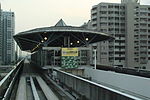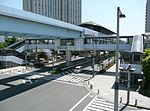Odaiba

Odaiba (お台場) is a large artificial island in Tokyo Bay, Japan, across the Rainbow Bridge from central Tokyo. Odaiba was initially built for defensive purposes in the 1850s. The land was dramatically expanded during the late 20th century as a seaport district, and was redeveloped in the 1990s into a major commercial, residential and leisure area. Odaiba, along with Minato Mirai 21 in Yokohama, is one of the few manmade seashores in Tokyo Bay where the waterfront is accessible and not blocked by industry and harbor areas. The majority of the island is located in Tokyo's Kōtō ward, with the north and northwest of the island in Minato and Shinagawa wards. Daiba (台場) formally refers to one district of the island located in Minato. Governor Shintaro Ishihara used Odaiba to refer to the entire Tokyo Waterfront Secondary City Center (東京臨海副都心, Tōkyō Rinkai Fukutoshin), which includes the Ariake and Aomi districts of Kōtō Ward and the Higashi-Yashio district of Shinagawa Ward.
Excerpt from the Wikipedia article Odaiba (License: CC BY-SA 3.0, Authors, Images).Odaiba
Daiba Oumi Road, Minato
Geographical coordinates (GPS) Address Nearby Places Show on map
Geographical coordinates (GPS)
| Latitude | Longitude |
|---|---|
| N 35.63 ° | E 139.775 ° |
Address
続日本100名城スタンプ124・品川台場
Daiba Oumi Road
135-0091 Minato
Japan
Open on Google Maps









